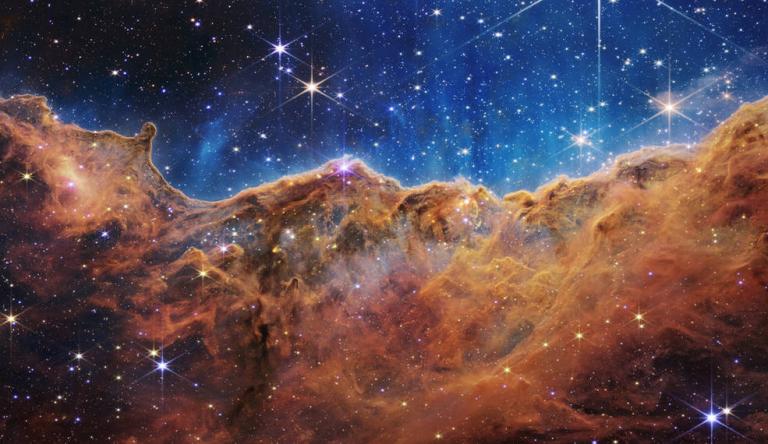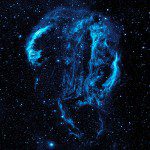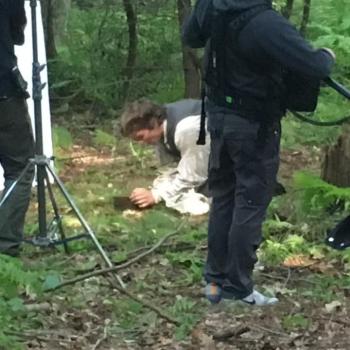
This landscape of “mountains” and “valleys” speckled with glittering stars is actually the edge of a nearby, young, star-forming region called NGC 3324 in the Carina Nebula. Captured in infrared light by NASA’s new James Webb Space Telescope, this image reveals for the first time previously invisible areas of star birth.
Called the Cosmic Cliffs, Webb’s seemingly three-dimensional picture looks like craggy mountains on a moonlit evening. In reality, it is the edge of the giant, gaseous cavity within NGC 3324, and the tallest “peaks” in this image are about 7 light-years high. The cavernous area has been carved from the nebula by the intense ultraviolet radiation and stellar winds from extremely massive, hot, young stars located in the center of the bubble, above the area shown in this image.
Recently, I’ve published four blog posts — see my “An initial survey of the “four fundamental forces” and the “cosmological constant” and “Initial Conditions and ‘Brute Facts’” and “Local” Planetary Conditions and “Three More “Local Planetary Conditions”” — that have been based on the online “List of Fine-Tuning Parameters” posted by Jay W. Richards. These four blog posts represent an initial pass through a topic that interests me very much and that, should I continue to survive past my sell-by date, I intend to deepen and extend considerably. They do not claim any originality for themselves or for me. And the same can be said about this blog entry itself.
The late atheist polemicist Christopher Hitchens is said to have called the fine-tuning argument “the most intriguing” among the arguments for the existence of God. The vocally atheistic physicist Sean Carroll has grudgingly termed it “the best argument that the theists have when it comes to cosmology.”
And it’s no wonder that Hitchens and Carroll and others have been at least slightly taken aback by evidence for fine-tuning. It can be quite impressive — and certainly so at first glance. If, for example, the strength of gravity were not “tuned” to one part in 10 to the sixtieth power, neither planets nor stars nor even galaxies could have been formed. And it’s impossible to imagine any way in which organic life could have developed in the absence of planets, stars, and galaxies. Wrong strength of gravitational force? No life. Period. End of story. Moreover, if positive and negative charge were not “tuned” to a fantastic degree of precision, no molecules would exist. And, accordingly, no organic life could exist. A third example: If the strong nuclear force, which provides the attraction between neutrons and protons, were just five percent weaker, the matter in the universe would be entirely made of hydrogen. If it were just five percent stronger, there would be no hydrogen at all. And life could not arise or survive — in any sense of which we can conceive — in either condition.
Unsurprisingly, though, there are those who don’t buy into the idea of cosmic fine-tuning, and they’ve mounted counterarguments to undermine it. They accuse its proponents of mere anthropomorphism or anthropocentrism, of falsely (and arrogantly) presuming that we humans are somehow the center of the universe.
One well-known response on the popular level is often called “the puddle analogy.” The most famous expression of it appears in The Salmon of Doubt: Hitchhiking the Galaxy One Last Time, a posthumously published collection of essays, talks, and unfinished fiction by the brilliant, hilarious, passionately atheistic, and sadly short-lived English writer Douglas Adams (1952-2001):
This is rather as if you imagine a puddle waking up one morning and thinking, “This is an interesting world I find myself in — an interesting hole I find myself in — fits me rather neatly, doesn’t it? In fact it fits me staggeringly well, must have been made to have me in it!” This is such a powerful idea that as the sun rises in the sky and the air heats up and as, gradually, the puddle gets smaller and smaller, frantically hanging on to the notion that everything’s going to be alright, because this world was meant to have him in it, was built to have him in it, so the moment he disappears catches him rather by surprise. I think this may be something we need to be on the watch out for.
What Adams is advancing in his characteristically witty way is a form of what is sometimes called the “Weak Anthropic Principle” or WAP. The WAP accepts as a given that, yes, the constants required for life to exist (the strengths of gravity and the electromagnetic force and the weak nuclear force, for example, and the balance of positive and negative charge, and so forth) are indeed very well tuned for the existence of life. But, suggests the WAP, this is not evidence for an intelligent designer. Life has adapted itself to the universe, according to the Weak Anthropic Principle, rather than the other way around. (My 27 February 2014 article for the Deseret News, “Maybe the firing squad was on your side,” is relevant here.)
Some atheists and critics of the idea of fine-tuning regard the “sentient puddle argument” (or something very like it) as a lethal knock-down blow against the idea. After all, if that sentient pondering puddle shouldn’t be surprised about how well it fits the hole in which it sits, we shouldn’t be surprised about fitting into the universe in which we fit.
The “sentient puddle argument” is an argument from or by analogy. In any analogical argument, the assumption is that, because A is similar to B, what is true of A must also be true of B. But, for such an argument to be solid, the analogy has to be a good one. And the similarity must be a relevant similarity. It should be fairly obvious that the fact that Clara is a lanky red-haired schoolgirl and is musically talented doesn’t establish that Alexis is also musically talented simply because she’s another lanky red-haired schoolgirl.
Obviously, no analogy is perfect. There will always be differences. (Otherwise, plainly, the relationship between X and Y wouldn’t be one of analogy but one of identity. X wouldn’t merely be similar to Y; it would be Y.) But the question must always be asked whether the similarities are significant and whether the differences are, for the purpose at hand, merely superficial. If the differences are significant and similarities merely superficial, the analogy is of no useful value and any argument based upon that analogy will fail.
So how does the “sentient puddle argument” fare? Spoiler alert: In my judgment, the differences between the puddle and the cosmos are significant and the similarities are merely superficial,
In an article entitled “The Trouble with Puddle Thinking: A User’s Guide to the Anthropic Principle” (in Proceedings and Journal of the Royal Society of New South Wales 154/1 [June 2021]), the Welsh-Australian astrophysicist Geraint F. Lewis and the Australian astrophysicist and cosmologist Luke A. Barnes explain the failure of the analogy as follows:
Consider more closely the puddle’s reasoning. Let’s name our puddle Doug. He has noticed a precise match between two things: 1) his shape and 2) the shape of the hole in which he lives. Doug is amazed! What Doug doesn’t know is that, given A) the fluidity of water, B) the solidity of the hole, and C) the constant downward force of gravity, he will always take the same shape as his hole. If the hole had been different, his shape would adjust to match it. Any hole will do for a puddle.
This is precisely where the analogy fails: any universe will not do for life. Life is not a fluid. It will not adjust to any old universe. There could have been a completely dead universe: perhaps one that lasts for 1 second before recollapsing or is so sparse that no two particles ever interact in the entire history of the universe.
In the puddle analogy, Doug the Puddle can exist in any hole. That’s the nature of puddles. The shape of the hole in which the puddle exists is essentially irrelevant to the existence of the puddle. If the shape of the hole is changed, the shape of the puddle will change. But, as long as there is a hole of some shape or other, the puddle will still exist.
But life is very different from a puddle. Life cannot exist in just any kind of cosmos. The fine-tuning argument recognizes that fact. If any one of a fairly large list of numbers were changed, life would not exist anywhere in the universe. If, for example, you were to increase the mass of the electron or of the up-quark, the result would be a universe utterly devoid of anything but neutrons. There would be no stars. No planets. There would be no chemistry — and, as an inescapable result, there would be no life.
So the “sentient puddle argument” rests on a false analogy. A life-permitting cosmos is hugely different from a puddle-permitting hole.
But we’re not quite done yet: Another way of trying to escape the “Strong Anthropic Principle,” the idea that the universe seems in some sense to have been designed to be friendly to life and even to intelligent life, is to posit the existence of an essentially infinite number of number of universes. On this notion, the fact that we just happen to live in a universe in which we can live (note the tautology) is pretty much sheer dumb luck, and not even especially interesting. (See the link to my Deseret News article above.) If I fall fifty-five thousand feet from a high-altitude airplane without a parachute and somehow land on my feet, completely unhurt, with my unspilled cup of Coke Zero and ice still in my hand, well, I just happen to live in a universe in which that happened. No questions needed. No mystery. Move along! There’s nothing to see here!
On the “sentient puddle” issue, see also William Lane Craig, “Barrow and Tipler on the Anthropic Principle vs. Divine Design,” British Journal for the Philosophy of Science 38 (1988), 389-395; Richard Swinburne, “Argument from the Fine-Tuning of the Universe,” in Physical Cosmology and Philosophy, ed. John Leslie (New York: Macmillan, 1990), 165–166.
















